PRESIDENT'S COMMENTS
Conservation. A noun. The act of conserving; prevention of injury, decay, waste or loss; preservation:.
We recently received some good news from the Province regarding conservation in west Niagara. The Greenbelt lands in Grimsby will remain the same, which prevents the severing of the Irish Grove Woodlot. The tall oaks and white pines appear to be safe for now.
Move approximately 50 kilometres east to another threatened habitat. A Niagara Falls woodland that contains 13 acres of provincially significant wetland. The parcels of wetland are within 486 acres of property where a $1-billion project is proposed to be developed and involves Chinese investors. The project which includes residential homes, restaurants and entertainment options is backed by the Regional and Municipal governments as well as Premier Wynne's endorsement of direct investment in Niagara but the significant wetlands are stalling the development.
What could aid in allowing the project to go ahead? Biodiversity offsetting. A term I was introduced to approximately one year ago.
Biodiversity offsetting involves a trade-off. Wetlands can be destroyed as long as they are restored or replaced elsewhere. Currently, there is potential policy using biodiversity offsetting with no net loss in the province of Ontario. The Niagara Peninsula Conservation Authority has recommended improving the trade-off. Instead of the one-to-one ratio, the NPCA propose three acres be restored for each one developed. In addition to recommending that offsetting should not apply to old-growth marshes and slough forests, the NPCA would like a pilot project to take place on the Niagara Falls property before introducing the policy province-wide.
The suggestion by a member of Regional Council to attempt biodiversity offsetting prior to the development project was not well-received. The developers do not want to put significant dollars in if they don't know it will work. What concerns me is that they are perfectly fine with going ahead with the pilot projection once construction has started.
The NPCA's involvement is also concerning. Thet have done some laudable work in the past, but to use biodiversity offsetting as a pilot project or case study research with less than 10 percent of wetlands remaining in Niagara is not the chosen path. Economic needs should not be included in a conservation authority's mission statement. They should be more concerned with the act of conserving; prevention of imjury, decay, waste or loss; and preservation when inportant or provincially significant natural areas fall within the Niagara Peninsula watershed and their authority.
SPEAKERS FOR THE REMAINING PFN MEETINGS IN 2016
| Sept. 26 | Adam Shoalts | Alone Against the North: Expedition into Unknown Landscape |
| October 24 | Justin Peter | A Naturalist's Rambles in India |
| November 28 | Janet Rose | The Importance of Composting (Also our dessert night) |
Harmony Resident Group's Dnd/Parks Canada Lakeshore Lands Future Proposal
Presented by Finn Madsen
On Monday, March 28, PFN member Ryder Payne and Finn Madsen of the Harmony Resident Group (HRG) treated the PFN Club to the Resident Group's Niagara-on-the-Lake lands proposal.
In brief, the HRG have proposed that the Lands should be turned into a natural heritage park, which would ensure: Habitat Protection; Conservation of wildlife species; Public access to Lake Ontario beaches; Public use of the wetland, creeks, grasslands and Carolinian forest areas for recreation and education consistent with maintaining the ecological integrity of the land; Recognition and preservation of heritage features; Changing the former waste-water tailing ponds (WWTP) to natural wetlands.
The site is filled with important natural and historic features, such as: The Battle of Fort George National Historic Site; The John Secord Homestead and WW 1 & 2 Military Training Grounds; 2 kilometers of Lake Ontario's southern shoreline; A significant fragment of Carolinian forest; 3 creeks and extensive sloughs and wetlands; 200-plus year-old oaks and maples; over 200 different species of birds; more than a dozen endangered species; stopovers for migrating shorebirds, songbirds and raptors; colony of Bank Swallows; flock of Wild Turkeys; an assortment of Carolinian forest flora and fauna, etc.
The lakeshore land-site is a 300-acre "island" of wildlife habitat surrounded by urban and agricultural development, except on its north boundary which is Lake Ontario. Its division into several distinct habitats makes it unique and worth preserving for future generations to enjoy. The lake itself is backed by a narrow beach and gravel bluffs. In summer and fall it is possible to walk the 2 kms of beach crossing over 2 substantial creeks whose mouths are occasionally blocked by gravel-bars. Carolinian forest runs along the east, north and west sides of the area. The forest undergrowth is rarely dense so one may easily walk through or follow the old military roads and well-worn paths through and around it. On the east side is the military firing range presently experiencing a thorough clean-up to make it safe for the public to access. The 3 creeks with their sloughs and wetlands make up another area. Two other distinct areas are Niagara Shores Park, open to the public and offering direct access to the lake and a trail around 3- Mile slough and wetland. The final distinct area is the soon-to-be-decommissioned tailings ponds WWTP, which HRG hopes to convert into a natural wetland. This will be available to the public by 2018.
Harmony Resident Group has strong support from Parks Canada, the town of Niagara-on-the-Lake, the Niagara Region, and the Niagara Peninsula Conservation Authority for its proposal. Public Information Meetings are now in progress for the future use of the DND/Parks Canada Lakeshore Lands and the decommissioning of the WWTPonds. The clean-up of the military training part of the site should be completed by 2018. So, within the next 2 years, HRG should know the fate of the lands and whether their 10 years of effort has been worthwhile. As a side-comment, Finn noted that Parks Canada seemed pleased that the HRG had taken the inituitive because Parks Canada was not certain what to do with the property. Also a previous group's suggestion had been to have a bandshell for outdoor concerts, which would have caused noise for the residents.
BIRDING COLOMBIA BY MARCIE AND JOHN
When Marcie Jacklin and John Black go birding, they always seem to find locations with scenic vistas, interesting cuisine, congenial birding friends, and knowledgeable guides/drivers. Also, somehow there is also often an issue involving airplanes and/or weather. Thus their recent birding safari to Colombia was a normal excursion. Their traveling team included Brad Clements and Ivor and Lynne. Various local drivers/guides were Johnnier Arrango, Pablo Florez, Gabriel (Gabo) Utria, Trevor Ellery, and others unnamed.
Similar to their Peru birding trip, this one to Colombia involved flying from Toronto to the capital Bogota, flying locally to Pereira, then driving to various locations at heights from 1900 to 3700 metres elevation. Some of the locations were: El Cedral Park; Navados National Park; Rio Blanca Reserve (2200 to 3700 metres); Tatama Nature Reserve; Montezuma Rain Forest & Eco-Lodge. This latter Eco-Lodge was run by Michelle Tatiana Tapasco and husband David Geale (born in Cobourg, Ont.). Another stay near the Tatama Reserve was at the house of the Echeverry family near Santario. Generally, the birding trips appeared to have been day-trips or over-nighters. Minor issues included aircraft problems (flat tire), travelling through rain and hail, and passports at air-terminals. Near the end, two of the group did some shopping.
The birds seen or heard (in order of seeing): Southern Lapwing; Roadside Hawk; Common Brush-finch; White-naped Brush-finch; Wattled Guan; White-capped Tanager; Red-ruffed Fruitcrow; Yellow-bellied Seedeater; Blue and White Swallow; Torrent Dick; White-capped Dipper; Multicolored Tanager; Crested Ant Tanager; Rufous-collared Sparrow; Great Thrush; Rufous Antpitta; Paramo Tapaculos; Tyrian Metaltail (a hummingbird); White-throated Tyrannulet; Andean Teal; Ruddy Duck; Stout-billed Cinclodes; Plain-coloured Seedeaters; Many-striped Canasteros; Brown-bellied Swallow; Sedge Wren; Helmetcrest; Brown-backed Chat-Tyrant; Cinclodes; Tawny Antpitta; Buff-bearded Helmetcrest; Andean Condor; White-chinned Thistletail; Shining Sunbeam; Black Flowerpiercer; Paramo Tapaculo; Black-backed Bush-Tanagers; Chestnut-crowned Antpitta; Brown-banded Antpitta; Powerful Woodpecker; Green-and-black Fruiteater; Gray-browed Brush-Finch; Bicoloured Antpitta; Emerald Toucanet; Andean Guan; Golden-faced Tyrannulet; Slate-coloured Antpitta; Oscillated Tapaculo; Bronzy Inca; Wedge-billed Hummingbird; White-throated Screech Owl; Rufous-banded Owl; Lined Quail Dove; Narino Tapaculo; Andean Solitaire; Peppershrike; Olive-sided Flycatcher; Red- bellied Grackle; Smooth-billed Ani; Black Vulture; Broad-winged Hawk; Rock Pigeon; Tropical Kingbird; American Kestrel; Bronze-winged Parrot; Rufous-tailed Hummingbird; Empress Brilliant; Bananaquit; White-headed Jacobin; Flame-rumped Tanagers; Purple-bibbed Whitetip (hummingbird); Munchique Wren; Chestnut Flowerpiercer; Scaly-naped Parrot; Rufous-collared Sparrow; Choco Tapaculo; Gold-ringed Tanager; Collared Seedeater; Flame-rumped Tanager; Squirrel Cuckoo; Palm Tanager; Blue-and-grey Tanager; Tropical Kingbird; Blackburnian Warbler; Bay-breasted Warbler; Crested Oropendola; Purplish-mantled Tanager; Purple-throated Fruitcrow; Striped Manikin; Rufous- breasted Antthrush; Chestnut-bellied Oropendula; Bay Wren; White-headed Wren; Parker's Antbird; Band-tailed Guan; Orange-chinned Parakeet; Tropical Kingbird; Swallow Tanager; Collared Aracari; Keel-billed Toucan; White-bearded Manikin; Bay-headed Tanager; Crimson-backed Tanager; Black- headed Tanager; Rufous-breasted Wren; Rufous-and-white Wren; Tennessee Warbler, Blackburnian Warbler; Prothonotory Warbler; Redstart; Baltimore Oriole; Summer Tanager; House Wren; Black- backed Antshrike; Pale-eyed Pygmy Tryrant; Osprey; Green Kingfisher; Lance-tailed Manikin; Roadside Hawk; Plain-bellied Thrush; Rufous-fronted Jacamar; Trinidad Euphonia; White-bellied Antwren; Yellow-bellied Elaenia; Blue-headed Parrot; Rufous-vented Chachalacas; Pearl Kite; Wood Stork; Double-striped Thick-knees; Russet-throated Puffbird; Brown-throated Parakeets; Pileated Finch; Vermilion Flycatcher; Orinocan Saltator; Vermillion Cardinal; Tocuyo Sparrow; Glaucous Tanager; Pale-legged Hornero; Pileated Finch; Yellow Caracara; Snowy Egret; Cattle tyrant; Northern Waterthrush; Yellow Oriole; Vermilion Cardinal; Ring-billed Gull; Herring Gull; Scarlet Ibis; Orange- headed Oriole; Yellow-rumped Cacique; Golden-winged Sparrow; Santa Marta Tapaculo; Blossomcrown (hummingbird); Emerald Toucanet; Keel-billed Toucan; White-winged Flowerpiercer; White-tailed Nightjar; Sickle-winged Guan; Mottled Owl; Santa Marta Antpitta; Rufous Antpitta; Strong-billed Woodcreeper; Plushcap; Southern Band-tailed Pigeon; Great Thrush; Buff-breasted Tanager; Yellow-billed Chat-tyrant; Mountain Elaenia; Grey-breasted Wood Wren; White-tipped Quetzal; Grey-throated Leaftosser; Black-hooded Thrush; Sierra Nevada Brush-Finch; Band-tailed Guan; Scaled Antpitta; Golden Fruiteater; Crimson-headed Woodpecker; Black-capped Tanager; Blue- capped Tanager; Masked Trogon; Sepia-capped Flycatcher; Venezuelan Flycatcher; Bat Falcon; Chestnut-winged Chachalacas; Snail Kite; Blue-winged Teal; Yellow Hooded Blackbird; White-faced Duck; Fulvous Tree Duck; Yellow-headed Vulture; Spot-flanked Gallinule; Bogota Rail; Silvery-throated Spinetail; Apolinar's Wren; Yellow Grassfinches; American Kestrel; Black-and-white Warbler; Blackburnian Warbler; Smoky Bush-Tyrant; Buff-breasted Tanager; Blue-capped Tanager; Black- crested Warbler; Capped Conebill; Rufous-browed Conebills; Moustached Brush-Finch; Plushcap; Chestnut-crowned Antpitta; Blackish Tapaculo;
Other animals: Spectacled Bear; Dwarf Squirrel; Red Squirrel; Crab-eating Fox; Red Howler Monkey;
Your Editor has not attempted to list all of the travels of the group - but thanks the leaders for supplying their itinerary along with the highlights. In case any PFN birder might be inclined to copy this group's 15-day trip, be advised that the current team generally were awake at 0400-0500 am local time, and frequently would be crashing in for the night around 1800 to 2200 or so - depending on whether they were trying to call in a bird with recordings. If you doubt this, their itinerary proves the case - these birders are DETERMINED! And any mis-spelling or duplication of names is the error of the scribe, not the birders!
2016 SPRING OUTINGS
Maple Syrup Walk (by Bob Highcock)
On Saturday, March 12, 20 participants met at the south entrance to Short Hills Provincial Park for the PFN Maple Syrup Walk. It was a beautiful March day for the annual outing. The sun was shining and the temperature was above freezing as the group walked along the Paleozoic Path to Swayze Falls. Spring had arrived early in the Town of Pelham. There was little snow and water was flowing over the falls. No frozen waterfall pictures this year. We observed 12 bird species which included Eastern Bluebird, Downy Woodpecker, Song Sparrow and Red-tailed Hawk.
Though the creek was flowing, the maple syrup did not this year. Unfortunately, due to circumstances beyond our control, the annual pancake lunch following the hike could not be held in the usual location. An alternate location was planned but due to an increase in business, the chance of all of the group entering the pancake house at the same time was slim. Despite the lack of pancakes and maple syrup this year, the group still enjoyed the Maple Syrup Walk. (Note the Participants photo on Page 8)
Lichens, Mosses and Other Plants of the Heartland Forest (by Roman Olszewski)
On the morning of April 9, Roman Olszewski led an outing in the Heartland Forest. The purpose of the outing was to identify liichens, mosses, and other plants in the Niagara Falls woodland. A hardy group of 15 joined Roman for the walk and within a minute or two, the first species of moss was observed.
How does one tell they are on a lichen walk? An hour has gone by and the group has only walked 100 metres. You will also hear a participant exclaim, "This is so awesome!" Yes, I did have my glasses handy but when looking at a Pin Lichen on a Bracket Fungus through a hand lens, I had to agree. It was awesome! *Re the Pin Lichen - pale brown spores would make the Pin Lichen that we found the species Phaeocalicium polyporaeum, while round spores would make it a Chaenotheca species. Both species grow on polypores (bracket fungi). Common name is Polypore Stubble.
The outing lasted for approximately 2 hours and though the temperature remained below freezing, the group enjoyed the walk and acquired an appreciation for lichens and mosses. Thanks to Roman for leading the interesting walk. (Below, Roman shows a specimen to a multi-aged group)
A list of moss and lichen species observed in Heartland Forest:
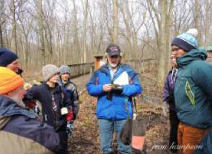
| Thuidium delicatulum | "fern moss" |
| Climacium americanum Brachythedium sp. |
"tree moss" |
| Fissidens taxifolius Bryum capillare Atrichum (oerstedianum?) |
"pocket moss" |
| Platygyrium repens Leptodictyum riparium |
"oil slick moss" |
| Plagiomnium cuspidatum | "woodsy mnium" |
| Physcia adscendens | "hooded rosette lichen" |
| Physcia aipolia or stellaris | "hoary rosette lichen" |
| Arthonia caesia | "frosted comma lichen" |
| Candelaria concolor | "lime lichen" |
| Lepraria finkii | "fluffy dust lichen" |
| Pin lichen on bracket fungus | *Note comments above - Phaeocalicium or Chaenotheca sp. |
Louth Conservation Area Wildf lower Walk, April 16 (by Brian Calvert)
My information from Brian was that the weather was inclement on this day, and only a few people came out for the walk. Some photos were taken by Marie Marrone and are graciously provided here.
St. John's C.A. Wildflower Walk, May 8 (by Brian Calvert)
Brian informed me that, of the few who showed up for this outing, most were members of the Geology Club.
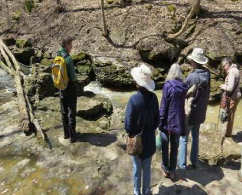
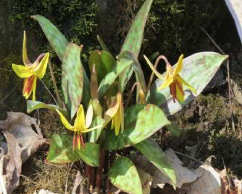
Brian leads a group at Louth, where the Trout-lilies were in bloom - by Marie Marrone
Fonthill Sandhill Valley Walk, May 7 (By Barbara West and Marlene Sanders)
On Saturday, May 7, a group of us went birding in the Sandhill Valley in Fonthill. The terrain was rather challenging, but there were many trails and lots to see. As far as birds went, we saw: Song Sparrows, Cardinal, Blue Jay, Chickadee, Mourning Dove, Robin, Goldfinch, Redwinged Blackbird, Blue-winged Warbler (a great sighting), Catbird, Tufted Titmouse, Red-breasted Nuthatch and White-breasted Nuthatch, Black-throated Blue Warbler, Downy Woodpecker, and Red-bellied Woodpecker and a female Cowbird. There were also many spring flowers: yellow and blue violets of different types, Christmas fern, and a few we could not identify yet as they were not completely out, spring beauty, red and white trilliums, mayapple, jack-in-the-pulpit, blue cohosh, trout lily, toothwort, skunk cabbage, solomon's seal, bloodroot, and long-spurred violet, just to name a few. We also saw lots of tadpoles and either a frog or a toad. He was too far under the water to get a good look. Some of the group stayed a little longer and went down another trail where they saw crows harassing something, possibly a Great-horned Owl. They also saw a chipmunk, a House Wren, and a raccoon sleeping in a tree. All in all, it was an interesting outing and we may do it again next year.
The Fonthill Sandhill Valley is south of the Niagara Escarpment, and is a non-escarpment feature that extends through the Fonthill Kame and into the Short Hills. The feature is made of a series of ridges and valleys that are up to 30m deep. The Fonthill Valley is covered by Carolinian forest rich in plant biodiversity. In the lower regions of the valley are swamps and meadow marshlands. Mixed wood forests occupy the higher regions.
Malcolmson Eco-Park Birding, May 17 ( by Barbara West)
On Tuesday, May 17, the early morning was very cool and damp. When I arrived at the Park, I found the entrance blocked off by construction equipment which caused much confusion as to where to park. We ended up being in divided into two groups. One entered from the back of the Park and the other from the front. However we did meet up in the middle and all was well. At first we saw only the more common birds: Bluejay, Cardinal, Goldfinch, Red-winged Blackbird, Catbird, Chickadee, Mourning Dove, and Downy Woodpecker. Then we started to see others: Carolina Wren, House Wren, Warbling Vireo, female Rose-breasted Grosbeak, White-breasted Nithatch, Song Sparrow, Flicker, Ruby-crowned Kinglet, and Great-crested Flycatcher. At one point, we came upon a spot where warblers were plentiful. We saw Yellow Warbler, Northern Parula, Chestnut-sided Warbler, Baybreasted Warbler, Blackburnian Warbler, Yellow Rumped Warbler, Black-throated Green Warbler and Tennessee Warbler. All in all, it turned out to be a successful outing.
An addition to the Malcolmson Eco-Park story, by Bob Highcock:
On Thursday, May 12, Bob And Jean were birding in the early evening when they discovered a trip-wire on a worn path, west of the pond. The wire was on the winding path that runs between the trail near the pond and the trail on the west side of the park. The wire was at shin level, so be careful when walking off the groomed trails. Bob removed the wire, but there may be more elsewhere. As for the birding, they observed their first-of-year (FOY) Great Crested Flycatcher and a Green Heron earlier. A Yellow Warbler was heard, and FOY Blackburnian, Bay-Breasted, and Chestnut-sided warblers seen, along with Palm, Black-throated Green, Black-throated Blue and Yellow-rumped warblers.
The PFN ANNUAL SUMMER PICNIC will take place on SATURDAY, JUNE 25, 10;00 AM to 3:00 PM (Rain or Shine).
R.S.V.P. to Bob Highcock 905-688-1260 or bob.jean@sympatico.ca
LOCATION: MERRITT ISLAND PARK PAVILION, WELLAND
DIRECTIONS: Take Highway 406 to Welland, and exit onto East Main Street at the Roundabout. Proceed on East Main Street and just past the Welland County Courthouse, turn right onto Cross Street. Keep driving on this road past the ship's mast on the right. Several hundred metres past the mast, you will come to a parking area. Leave your car there and walk along the paved trail for about 80 metres to the pavilion on your right,
Washrooms are available in the building adjacent to the parking area. If for some reason the parking area is full, you will have to drive back and park in the parking lot behind City Hall/Library. There are no parking fees on Saturday. A variety of sandwiches including vegetarian will be provided. Bottled water and coffee will be on hand. Members attending the picnic are invited to bring a cold salad and additional drinks for the picnic.
A hike on the trail along the Welland River will take place prior to lunch; Bob Highcock to lead the walk.
If you are coming from south of Welland and need directions, please call Roman Olszewski at 905-734-9574 (before the day of the picnic).
CONGRATULATIONS to JOHN BLACK for receiving the City of St. Catharines Volunteer Recognition Award on April 12, 2016. John has lead various bird-watching trips for the Club and has given numerous presentations as a guest speaker. From 2005 to 2015, John served on the PFN Board as a Director. In the photo, John is shown with Councillor Joe Kushner (a Brock friend), Mayor Walter Sendzik and Councillor Matthew Siscoe. John said he and Jean had a great dinner at the Parkway Convention Center.
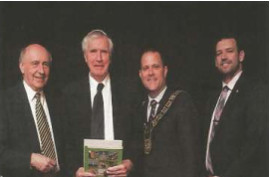
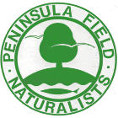
The Peninsula Field Naturalists Club
A non-profit organization started in 1954 with the objectives to preserve
wildlife and protect its habitat, to promote public interest in and a knowledge
of the natural history of the area, and to promote, encourage and cooperate with
organizations and individuals having similar interests and objectives.
Affiliated with Ontario Nature and Nature Canada.
P.O. Box 23031, RPO Carlton, St. Catharines, ON. L2R 7P6
Website : peninsulafieldnats.com
The Peninsula Naturalist
Published: February, April/May, October/November
The Editor welcomes written articles or artwork on any natural history topic.
Please submit typed reports on paper or by email to: jmpotter068@gmail.com
Colour photos (jpg) accompanying articles are welcome. All pieces of artwork
will be accepted. New ideas and constructive criticism are welcome. Please send
submissions by email to e-address above, or by snail-mail to the Club’s postal
address.
Editor: John Potter
Assistant: Mary Potter
–
The Peninsula Naturalist Newsletter,
Published: February, April?; October/November
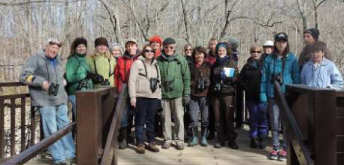
Download the complete newsletter pdf
